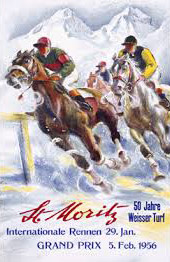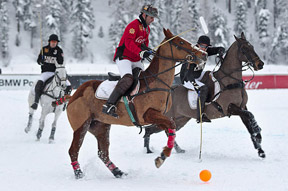
Skijoring action.
St. Moritz, Switzerland can be credited with a lot of firsts: it was home to the first place in Switzerland to have electric lights, it was the birthplace of spa resorts and, in 1864, winter sports and tourism were founded. Finally it was the first place that the winter sport of skijoring – from the Norwegian word “snorekjoring” which means driving with ropes – was created. Sadly this winter sport where rider less horses pull skiers has never really been replicated with the same enthusiasm in any other place, so the Swiss have become the undisputed masters of this snowy winter wonderland dash!
In 1906, the first White Turf skijoring races were held on a 10-kilometre (6.376 miles) stretch of road from St. Moritz to Champfer, with the horse/skier teams starting at one-minute intervals. The following year trotting horse races were added, and then the St. Moritz Racing Association was founded. In 1908 six events were held with betting and just two years later, the event was extended to three days per winter. Flat racing was added in 1911 and steeplechasing in 1922. Strangely enough, efforts to have a summer racing event never took off, but the winter events have thrilled race goers for decades. Each February around 35,000 of the world’s jet setters arrive en masse to party, drink champagne, and to cheer on their favorite horses, skiers, riders, and drivers. Sadly the exciting sport of skijoring has never been seriously considered as an Olympic sport though it was a demonstration sport in the 1928 games. Switzerland won first, second and third place medals!

Old poster for St. Moritz racing.
These days, the skijoring races are held on a racetrack on Lake St. Moritz which freezes 60cm (1.968 feet) thick. While this looks fun and easy, the starts can be very dangerous as the thoroughbreds know exactly what is happening and in their excitement to start, reins get crossed, and this “hopeless confusion” is well termed. In 1965, so disastrous was the race that not one team finished! Because of the potential dangers, the horses and riders need to prove that they are both “in the know” and stringent testing is done. The teams are travelling over a course that is 2,700 metres long (8858 feet) and at speeds that can reach 50 kilometres per hour. (31mph). Then throw in blowing snow, snow and ice thrown up from hooves, and the need for athleticism, skill, and balance is obvious. The skier with the most points from three consecutive racing Sundays in February is crowned King of the Edgadin Valley.
While the winter races in all forms were stopped for WWII, they were re-launched in 1952. Since 1998, the racing has been managed and organized by the White Turf Racing Association, and the group organizes, promotes, and oversees every detail of the annual event that also include polo using a red ball for visibility. Betting is available and the purses for the various races are nothing to sneeze at. Whether for skijoring, flat or harness racing on any of the three consecutive Sundays in February, prize money ranges from about $15,000 US to $111,000 US and sponsors include such notables as Credit Suisse Bank since 1976, and BMW since 1991. The total prize money of around 480,000 ($465,100 US) draws top horses from France, Germany, England, Switzerland and Italy.

Polo on snow.
Horse racing in Switzerland was actually held first on September 29th in 1872 in Zurich. While the racing industry has grown over the decades, it does not constitute a branch of industry as we see here in North America, England or France. However, while Swiss horse racing doesn’t make the international headlines like the Kentucky Derby or the Grand National, there is an exception every year in February when St. Moritz plays host to horse racing on ice and snow, and the world is invited.
Being a part of the jet set doesn’t come cheap however. St. Moritz has always played host to the cream of the crop, and to play with the well-heeled crowd in St. Moritz in February is big bucks. If you are looking for a winter getaway, St. Moritz style, the dates for the 2015 White Turf events are February 8, 15, and 22.
